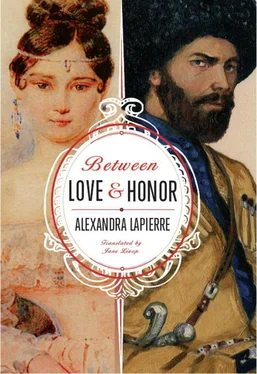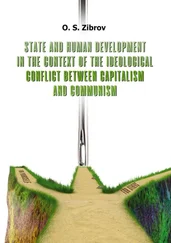Patimat:Shamil’s older sister, born around 1795, killed at Akulgo in 1839.
Piotrovsky:Russian physician who treated Jamal Eddin in Soul-Kadi in 1858.
Potemkina, Tatiana Borissovna(1797–1869): daughter of Boris Andreyevitch Golitzine. At eighteen she married Alexander Mikhaïlovitch Potemkin, a marshal of the Saint Petersburg aristocracy. She owned several properties, one of which, Gostilitsy, was located near Peterhof. In Saint Petersburg, she lived on the well-known Million Street. A mystic and proselytizer, she prided herself on her prison visits and on the thousands of Muslims and Jews she had supposedly converted. Her great-niece Elizaveta Petrovna Olenina spent much of her time with Jamal Eddin in La Potemkina’s homes, at Gostilitsy, in Saint Petersburg, and at her property close to Torjok between 1850 and 1854.
Poullo, Colonel-General Nicholas:officer known for his cruelty, who met Shamil at Akulgo to attempt to open negotiations on August 16, 1839.
Preobrajensky Regiment:with the Chevaliers-Gardes and the Gardes-à-Cheval, the most prestigious regiment of the czar’s army.
Priutino:Alexis Nicolaïevitch Olenin’s family home hear Saint Petersburg, sold in 1838.
Pushkin, Alexander Sergueïevitch(Moscow, 1799–Saint Petersburg, 1837): Considered Russia’s greatest poet, he wrote splendid texts about the Caucasus, notably the myth of The Prisoner of the Caucasus , published in 1821.
Saïd:Shamil’s third son, killed by the Russians with his mother Jawarat as they fled from Akulgo in 1839.
Saïd al-Harakan:partisan of the Russians and mentor of the first imam of Dagestan, Khazi Mullah, who would eventually raze his home and burn all of his books.
Shamil:father of Jamal Eddin, third imam of Dagestan. Born in Ghimri in 1797, died at Medina in 1871.
Soul-Kadi:village where Jamal Eddin died July 12, 1858.
Shibshiev:Jamal Eddin’s servant from 1849 to 1853.
Sinandali:Chavchavadze property in Georgia, from which the princesses were abducted in 1854.
Temir-Khan-Chura:Russian fort close to Ghimri and Akulgo from which Jamal Eddin was sent to Moscow in 1839.
Terek:Caucasian river celebrated by Pushkin, Lermontov, and Tolstoy.
Tiliq:city besieged by General Fézé in July 1837, from which Shamil was obliged to send his nephew Hamzat as a hostage.
Tolstoy, Leo Nicolaïevitch(1828–1910): one of the greatest Russian novelists of all time, who knew the Caucasus well and lauded it in his works. He fought there in 1854 and was haunted by the memory for the rest of his life. Author of Cossacks (1853) and Hadj Murat (1904).
Torjok:garrison town in the province of Tver, where Jamal Eddin’s regiment of the Vladimirsky Lancers was stationed from 1851 to 1854.
Tsarskoye Sielo(the village of the czar): town outside of Saint Petersburg where Jamal Eddin first studied. Summer residence of the imperial family, where he was received between 1847 and 1853. One of the imperial parks housed the “Invalides,” a home for horses put out to pasture and its cemetery.
Ulluh Bey:outlaw that General Grabbe commissioned to poison Shamil in 1840.
Untsukul:native village of Fatima, first wife of Shamil and mother of Jamal Eddin. The village was razed by the imam for having betrayed him.
Varenka:see Grunzinskaya, Varvara Ilyinitchna.
Vladikavkaz:Russian fort.
Vladimirsky Lancersor Uhlans:regiment under the command of the czar’s brother, Mikhaïl Pavlovitch, which Jamal Eddin joined as a cornet June 9, 1849. At the death of Grand Duke Mikhaïl Pavlovitch on September 19, 1849, the regiment passed into the hands of Grand Duke Mikhaïl Nicolaïevitch, the seventeen-year-old son of Czar Nicholas and former classmate of Jamal Eddin. The Vladimirsky regiment became the thirty-eighth regiment of Vladikavkaz in 1862, when Grand Duke Mikhaïl Nicolaïevitch was named viceroy of the Caucasus and established his residence at Tiflis.
Vorontsov, Mikhaïl:named viceroy of the Caucasus in 1844. One of the Russian dignitaries who was remembered in Tiflis in a favorable light.
Yermolov, General Alexey Petrovitch:viceroy of the Caucasus known for his brutality, recalled after the revolt of the Decembrists. Shamil met him in Saint Petersburg in 1859.
Youssouf:classmate of Jamal Eddin in the First Cadet Corps of Saint Petersburg.
Yunus:the most faithful of Shamil’s captains and Jamal Eddin’s tutor, in charge of his education. He brought Jamal Eddin to the Russian fort of General Grabbe in 1839 and identified him sixteen years later upon his return, at Khassav-Yurt. He was in charge of negotiations between Shamil and Prince Bariatinsky and can be seen in all the depictions of the murid surrender at Gunib in August 1859.
Zaïdet:third wife of Shamil, born in Ghazikumuk in 1823, died at Medina in 1870. Daughter of Sheik Jamaluddin al-Ghumuqi al-Husayni, she married Shamil after the death of Fatima in 1845.
During my long quest in the footsteps of Jamal Eddin, six books were always with me. If they made my bags heavier, every time I read them I felt lighter, filled with renewed enthusiasm. They always revived my curiosity and gave me courage again in my moments of doubt. Over the years and on the paths of so many journeys, their authors have become my mentors, my partners, my traveling companions. I’d like to offer them a sentimental word of appreciation here.
First of all, a nineteenth-century Frenchwoman who traveled extensively, the first to have met some of the protagonists of Jamal Eddin’s story, who wrote of her own adventures in the Caucasus. Anne Drancey opened a bookstore in the Georgian capital in 1853. When her business failed, she took a position as governess to the Chavchavadze princes.
During the attack the Tiflis press would call “the hostage taking of the century,” she was abducted with the other women of the household by the Imam Shamil. The account of her life in captivity, magnificently edited by Claudine Herrmann at Mercure publishing house, in France, was reprinted in 2006, entitled Captive des Tchéchènes ( Captive of the Chechens ).
Some of Madame Drancey’s anecdotes inspired one of Leo Tolstoy’s masterpieces, Hadji Murad , as well as several chapters of Alexandre Dumas’s Voyage au Caucase , two other works that have frequently accompanied my research. Dumas devoted about ten pages to the story of the sacrifice of Jamal Eddin, based upon his interviews with the Georgian princesses who owed the young Chechen their lives.
Following Dumas, English author John F. Baddeley did extensive research on Dagestan between 1879 and 1902, resulting in a veritable gold mine of information. He observed the ways and customs of the Caucasus with a rare degree of humility and questioned the Montagnards intelligently. He drew landscapes and photographed the countryside. The exhaustive works he then published, The Russian Conquest of the Caucasus and The Rugged Flanks of the Caucasus , are the invaluable product of his labor. Every biographer of the imam since then has used the collection of anecdotes and accounts in his books as an important source.
And last of all, the fascinating work of Lesley Blanch, The Sabres of Paradise . Published for the first time forty-eight years ago by John Murray Publishers in England, it was released in France three years later in a magnificent translation by Jean Lambert, Les sabres du Paradis . Editions Lattès published it then, and it was reprinted in 1990 and again in 2004 by Editions Denoël. Lesley Blanch’s work remains, in my eyes, the most beautiful book ever written concerning this region of the world.
Читать дальше












